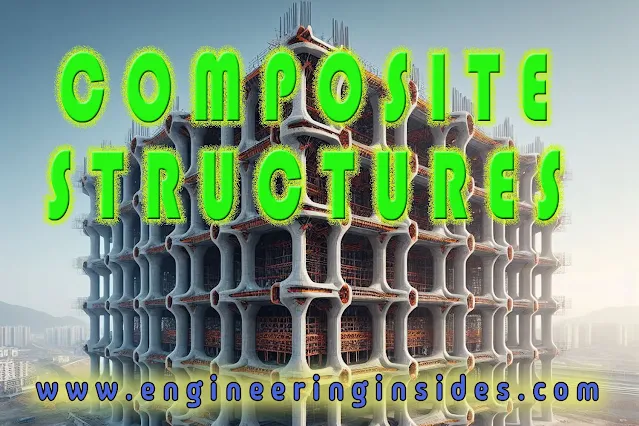In construction industry, composite structures have emerged
as a brilliant solution, combining the power and durability of steel with the resilience
of concrete. This system offers engineers and architects a wide range of
possibilities for constructing efficient, and aesthetically pleasing buildings.
In this article, we will understand the concept of composite structures using
concrete and steel, discussing their benefits, applications, design
considerations, and future prospects.
Composite Structures:
Composite structures, as the name suggests, combine two or more materials with distinct properties to create a single, unified system that surpasses the overall abilities of the individual material. In construction, composite structures typically involve the combination of concrete and steel. They increase the combined strengths of each material to achieve high performance in terms of load-bearing capacity, durability, and structural integrity.
Advantages of Composite Structures:
1. Enhanced Strength and Stability:
By combining the
compressive strength of concrete with the tensile strength of steel, composite
structures resist better against structural stresses, including bending,
shearing, and torsion.
This combination
results in structures that can bear heavy loads and environmental conditions, giving
long-term stability and safety.
2. Flexibility in Design and Construction:
Composite
construction allows for greater flexibility in architectural design, enabling
the creation of expansive spans, intricate shapes, and innovative geometries.
Moreover, the
lightweight nature of composite materials facilitates faster construction
processes, reducing overall project timelines and costs.
3. Sustainability and Environmental Benefits:
Utilizing
composite structures with concrete and steel promotes sustainability by
optimizing material efficiency, minimizing waste, and reducing carbon
footprint.
Additionally, the
durability of composite buildings extends service life and decrease maintenance
requirements.
Applications of Composite Structures:
1. High-Rise Buildings and Skyscrapers:
Composite
structures are ideal for tall buildings where strength, stability, and
flexibility are paramount. By utilizing steel-reinforced concrete cores and
composite floor systems, engineers can achieve optimal balance between
structural performance and architectural aesthetics.
2. Bridges and Infrastructure Projects:
Composite
materials offer significant advantages in bridge construction, enabling the
development of lightweight yet robust structures capable of spanning large
distances.
From highway
overpasses to pedestrian walkways, composite bridges demonstrate exceptional
durability, resistance to corrosion, and ease of maintenance.
3. Industrial Facilities and Warehouses:
In industrial
settings, composite structures provide efficient solutions for constructing
warehouses, manufacturing plants, and storage facilities.
The combination
of concrete and steel delivers the strength and durability required to support
heavy machinery, equipment, and storage loads, while also accommodating
flexible layout configurations.
Design Considerations for Composite Structures:
1. Material Selection and Compatibility:
Choosing the
appropriate grades of concrete and steel is crucial to achieving optimal
performance and durability in composite structures.
Engineers must
consider factors such as material properties, compatibility, corrosion
resistance, and environmental conditions to ensure long-term structural
integrity.
2. Composite Connection Details:
Effective
connection design is essential for transferring loads between concrete and
steel elements within a composite structure.
Welding, bolting,
and adhesive bonding are common methods used to create robust connections that
withstand dynamic loads and maintain structural stability over time.
3. Fire Resistance and Thermal Performance:
Composite
structures must be engineered to withstand fire hazards and maintain structural
integrity under high temperatures.
Fire-resistant
coatings, insulation materials, and thermal barriers can enhance the fire
performance of composite elements, safeguarding occupants and minimizing
property damage.
Future Trends and Innovations:
1. Advancements in Composite Materials:
Ongoing research
and development efforts are focused on enhancing the properties of composite
materials, including self-healing capabilities, lightweight reinforcements, and
sustainable alternatives.
Emerging
technologies such as carbon fiber-reinforced polymers (CFRP) and
ultra-high-performance concrete (UHPC) are poised to revolutionize the field of
composite construction.
2. Integration of Smart Technologies:
The integration
of sensors, actuators, and monitoring systems enables real-time performance
assessment and predictive maintenance of composite structures.
Smart
technologies enhance safety, efficiency, and resilience by providing actionable
insights into structural behavior, load distribution, and environmental
conditions.
Composite structures utilizing concrete and steel represent
a paradigm shift in modern construction, offering unparalleled strength,
durability, and versatility. From iconic skyscrapers to essential
infrastructure projects, composite materials continue to redefine the
boundaries of architectural innovation and engineering excellence. As we look
towards the future, ongoing advancements in materials science, technology, and
sustainable practices promise to further elevate the capabilities and
sustainability of composite construction.


